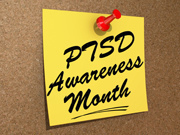Identifying Post Traumatic Stress Disorder
Military veterans may be entitled to certain benefits to help with financial, medical, and similar difficulties as a result of their service. Some of those benefits accrue when a veteran suffers a service connected injury. It is crucial for those suffering in any way as a result of their service to understand the programs open to assist in their full recovery.
One of the most important such programs involves support and disability benefits for post-traumatic stress disorder (PTSD). PTSD refers to a severe anxiety disorder that many service members develop following psychologically tragic events. The most widely recognized are those related to a combat zone. However, PTSD may result from service in the military even for those that never entered combat.
The United States Department of Veterans Affairs (VA) provides disability benefits to service members experiencing PTSD that is connected to their service in the military. Again, the service connection need not be related to combat. However, the burdens of proof do vary depending upon the types and circumstances of stressors.
PTSD is generally associated as having four main symptoms: avoidance, numbing, re-experiencing, hyper-vigilance and sleep disturbance with nightmares. Not everyone who goes through a trauma will develop PTSD nor will trauma necessarily result in PTSD disability benefits. Instead, only those who show a persistent pattern of some or all of those four symptoms are likely affected.
In general, a mental health provider must make the diagnosis. In most cases the professionals will begin by conducting a “screen” to determine if further analysis is needed for the individual. The screen is often a series of simple questions, which gauges some warnings signs of PTSD. If one tests “positive” on the screen, the professional will likely conduct a more in-depth assessment.
There is no one-sized-fits-all approach to PTSD assessments. Much will depend on the specific trauma experienced, symptoms, and training of the mental health professional. Most cases will involve some extended questioning by the therapist. Those questions will likely relate to the exact types of trauma experienced and the symptoms you have shown. In addition, your friends and family may be asked questions and you may be given a battery of standardized psychological tests.
Many professionals will conduct standardized interviews. Two of the most common are the Clinician Administered PTSD Scale (CAPS) and Structured Clinical Interview for DSM (SCID). CAPS is by far the most commonly used test, involving questions about the presence and intensity of common PTSD symptoms. SCID is less specific. It measures a wide range of mental health disorders of which PTSD is just one. At times one of these tests conducted by a professional might be paired with standardized self-reports. These are questionnaires completed by the service members themselves and can usually be printed out and taken on one’s own time.
These sessions can last anywhere from 15 minutes to an hour or several hours. In fact, it is not uncommon for a series of hourly sessions to be conducted. Importantly, for legal purposes it is helpful to have clear, thorough, and comprehensive records of assessments from mental health professionals. Documentation of these evaluations is important when applying for disability benefits to receive help for one’s PTSD.
In the past, the VA has been rather tough on PTSD evaluations. Due to the high rate of PTSD in veterans returning from Iraq and Afghanistan and the fact that many PTSD sufferers were going untreated, the VA has reduced the burden of proof for PTSD disability ratings. It is important to discuss these matters with your Veterans Service Representative and if necessary with a VA accredited attorney.

